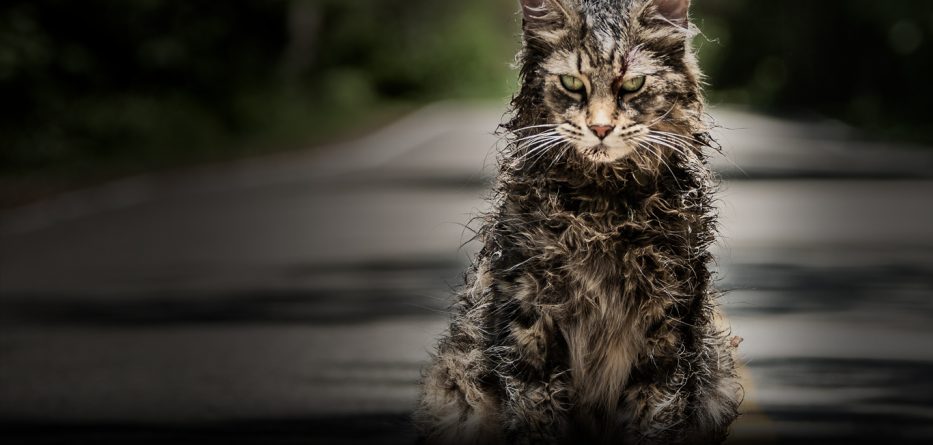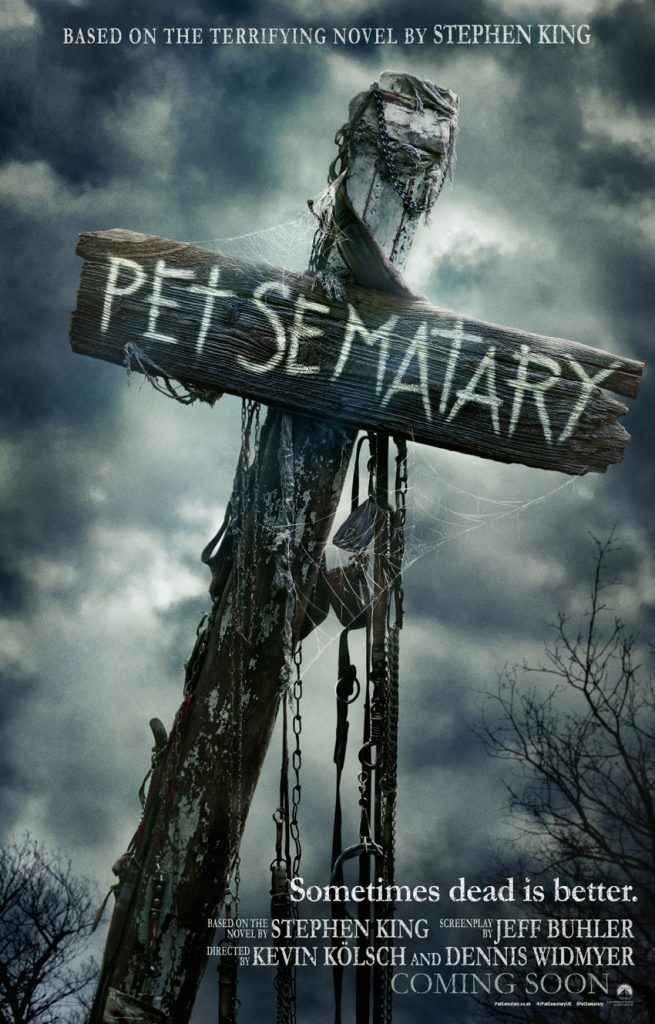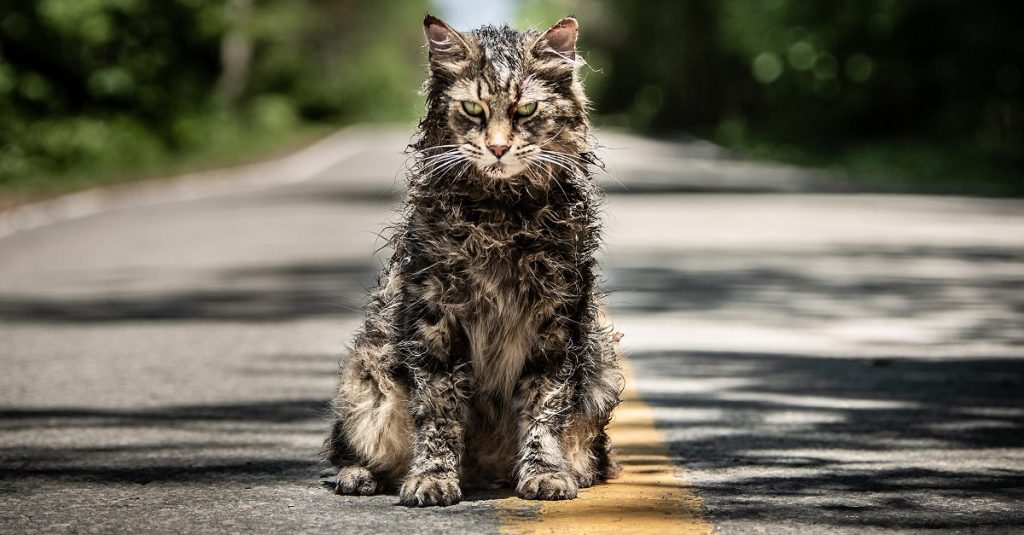Saying Stephen King is a prolific writer would be like saying Mike Trout is good at baseball. The very
definition of an understatement. King has written over fifty books, all of them bestsellers, and most of
them eventually being adapted for the silver screen. Some of the resulting movies have been quite good
– The Shining, Christine, and Silver Bullet, to name a few – and some have been…well, let’s just say forgettable and leave it at that. Some of the movie adaptations of King’s work have even been around long enough to be remade*, which brings us to Pet Sematary. I remember very little of the original theatrical representation that was released in 1989 other than Fred Gwynne, otherwise known as Herman Munster, playing the role of Jud. It’s been thirty years, so why not revisit the well? As I have bitched about before, horror movies these days are all about supernatural plot lines and giving the audience “jump scares” and a remake of Pet Sematary would promise to deliver on both counts. Still…the trailer I had first witnessed back around Christmas, with the sound of the loon crying in the wilderness, the masked children, and the narration by John Lithgow as Jud was extremely enticing, and The Doctor would be lying if I said that I didn’t get somewhat excited about the prospects of the latest iteration of Pet Sematary. Would this prove to be a a case of a great trailer and a less-than-stellar movie? Well, it’s far too early to tell, at least until I buy my ticket, lace my popcorn with butter, and spike my Sprite…
THE FILM – PET SEMATARY (2019)
Dr. Louis Creed (Jason Clarke) and wife Rachel (Amy Seimetz) along with their two children, soon-to-be
nine Ellie and toddler Gage, have escaped the urban blight of Boston for the pastoral hamlet of Ludlow,
Maine. The impetus for the move is not only to leave behind the city of Boston, but also for Dr. Creed to
exchange his job as an ER physician working the graveyard shift for the much more comfortable
occupation of campus doctor at some small New England college. Speaking of which, Campus Doctor
sounds like it’s directly in my wheelhouse. I should probably look into that.
Soon after moving into their sprawling, rustic home in the Maine countryside, Ellie and her mother are
going for a walk in the nearby woods when they witness a funeral procession of several children
marching in order down a dirt path. The prepubescent children are all wearing animal masks while one
of them plays a somber beat on a homemade drum… and then they are gone, never to be seen, heard, or
spoken of again. The masked, marching children were part of the eerily intoxicating trailer that had me
anticipating this film before 2018 had ended, so the fact that they serve as nothing more than the briefest of bridging devices in the movie was slightly disappointing for The Doctor.

This scene was integral to the Pet Sematary trailer and set the tone for the film, however it was sadly not revisited…
Ellie then decides to go exploring the woods on her own and finds the Pet “Sematary” where the citizens
of Ludlow have been interring beloved dogs and cats and the odd parakeet for generations. While
attempting to climb the barricade of gnarled, twisted logs and tree branches at the cemetary’s perimeter,
Ellie is warned away from danger by the elderly Jud Crandall (John Lithgow) who then befriends Ellie
and the Creed family. A major part of King’s novel is how Crandall becomes a father-figure to Louis, who
had lost his biological father at a young age. This relationship development is almost non-existent in the
fim, but, as I and others far better suited to the purpose than myself have stated, this is a natural
byproduct when novels are adapted into a working screenplay. The novel is 395 pages long in trade
paperback form and the running time of the film is 101 minutes. In other words, shit happens, or more
precisely, shit doesn’t happen because no studio is going to greenlight a four-hour film. A movie cannot
be faulted for that (a movie can be faulted for a great many things, but generally not that).
It’s only a matter of time before Ellie’s cat Church runs afoul of one of the tanker trucks that use the road at the far end of the Creed property, a fact that the realtor apparently failed to divulge. Church must have been merely clipped rather than run over as as he isn’t flattened into a pancake, but whatever
transpired was still enough to send him on his way to cat heaven.
It is at this juncture of the film where the character of Jud Crandall makes a choice that is mostly
contradictory to his previous behavior. Jud had long been aware of the haunted Indian burial ground that
lies beyond the Pet Sematary, but thus far he has seemingly tried to hide the fact of its existence from
the Creeds. Once Church’s carcass has been discovered, however, he performs an emotional flip-flop.
Reasoning that little Ellie’s friendship has provided his old heart with happiness – these scenes must
have been left on the cutting room floor – Jud leads Louis past the deadfall of branches and into the
haunted zone to bury Church. Has anything good ever come from visiting an ancient, haunted Native
American burial ground? I don’t think so.
Anyway, Jud leads Louis beyond the Pet Sematary and into the misty, purple, shrouded woods of the
haunted burial ground… and I thought the set was a tad pedestrian for a Hollywood studio picture. First of all, it was clearly a sound stage and not a real location. This in itself is okay, but the fact that it looked like something that a community college theater department might have created with some ambient lighting and a dry ice machine is borderline unforgivable. I thought Boris Karloff might wander out at any moment trailing mummy bandages. I love the old Universal horror classics, but with apologies to Karloff, Bela Lugosi, and Lon Chaney Jr., in 2019 this level of production value should be of the past.

John Lithgow and Jason Clarke look for the ghost of Lon Chaney Jr. in “Pet Sematary”. Unfortunately he fails to appear.
Church is reanimated and patting around the homestead by the next morning, although he is no longer
the same old cuddly cat that he used to be. He’s, well… ornery somehow. Louis then confronts Jud and
gets the full lowdown concerning the burial ground. Jud had buried the family dog “Biffer” in the haunted
ground many decades ago and Biffer came back… although he wasn’t his usual self, either. In fact, he
was mean and nasty and attacked Jud’s mother, forcing his father to put Biff down. Gee, thanks Jud.
Talk about Bad Idea Jeans. You might have informed me of that seminal detail earlier. In fact, if I were
involved instead of the fictional Louis Creed, I imagine the conversation going something like this:
Jud: “Let’s bury Church in the haunted Indian burial ground beyond the Pet Sematary. He’ll come back to life.”
Doc: “I’m sorry, what the hell did you just say?”
Jud: “It’ll make your little girl happy… unless, of course, Church comes back possessed and starts violently clawing anyone who touches him, which is probably going to happen.”
Doc: “We’ll get a new fucking cat, on my way home from the liquor store.”
After Church claws Ellie’s arm and gives her a nasty scratch, Louis decides that maybe playing God is a bad idea and decides to drive the cat to the outskirts of town and leaves him there, I guess hoping that Church will wander away into the woods and get eaten by something. Suffice it to say that this does not happen, and Church makes his way home at the moment that Ellie is having a birthday party and maybe one of the kids runs into the road in front of an oncoming tanker… and since the novel and the original film are now both three decades old and the story of Pet Sematary is well known, I think I can leave the plot at that.
Is Pet Sematary a good movie? The acting certainly delivers. Jason Clarke, whom I really enjoyed in Dawn of the Planet of the Apes, and Amy Seimetz make for a believable young married couple and are capable of projecting emotional vulnerability that will make audience members empathize. John Lithgow, now in his seventies, has been delivering memorable performances in film and television for decades in a variety of differing roles and his professional talent is on display here. The young Jete Laurence gives a frighteningly realistic performance as Ellie Creed, and the cat playing Church stole every scene he was in. OK, maybe I was being a bit facetious with that last one, but whatever faults Pet Sematary has does not lie with the actors. The tension factor never lets up throughout and that is worth noting… in my opinion, however, the trailers promised limitless possibilities and the film just doesn’t quite live up to them. That said, it is still an entertaining film and like the original source material of King’s novel, it’s unforgivingly dark. I realize this review makes me a bit of a fence-sitter on Pet Sematary, but I think you will have to form your own opinion on this one. I can see it serving its purpose on a Saturday night in the near future when you are cuddled on the couch with your significant other and a bowl of buttered popping corn. Steer clear of ancient Indian burial grounds. As always, dear friends, The Doctor wishes you all a clean bill of health.
* There are multiple versions of Carrie (1976, 1999, 2002, 2013) and The Shining (1980, 1997) and King’s short story Trucks served as the basis for Maximum Overdrive (1986) – revisit the Tuesday Night Cigar Club archives for our podcast here – before getting it’s own release as Trucks in 1997. In a footnote to a footnote, King didn’t care for Stanley Kubrick’s The Shining, mostly because of Jack Nicholson’s being involved, and preferred the remake. Go figure. King is a literary genius and his positions on the adaptations of his work need to be considered, but most filmophiles – especially TNCC chairman Matthew Cade and The Doctor – will respectfully disagree.
Appendix (carrying a SPOILER)
This isn’t much of a spoiler alert since King’s novel was originally published in 1983, but if you aren’t aware of the details, you can stop here. The novel goes thusly: Creed and his family have relocated to Ludlow from Chicago (instead of Boston.) The cat gets killed and Louis buries it in the supernatural burial ground. The cat comes back nasty. The little boy Gage is then hit by a truck and buried by Louis, only to come back (of course) nasty and demonic as well. Gage then kills Jud and his own mother before Louis kills his reanimated son. Reasoning that if he buries his wife more quickly following her death than he did with his son, Louis buries Rachel. I’m not sure where this registers on the scale of terrible ideas, but it has to be up there. On the final page, Louis feels Rachel’s hand on his shoulder, and we are left to wonder what happened. My apologies to King for this cheaply truncated synopsis. The events of the film differ slightly in terms of the choices that are made, but not radically so, with the exception of the ending.
















